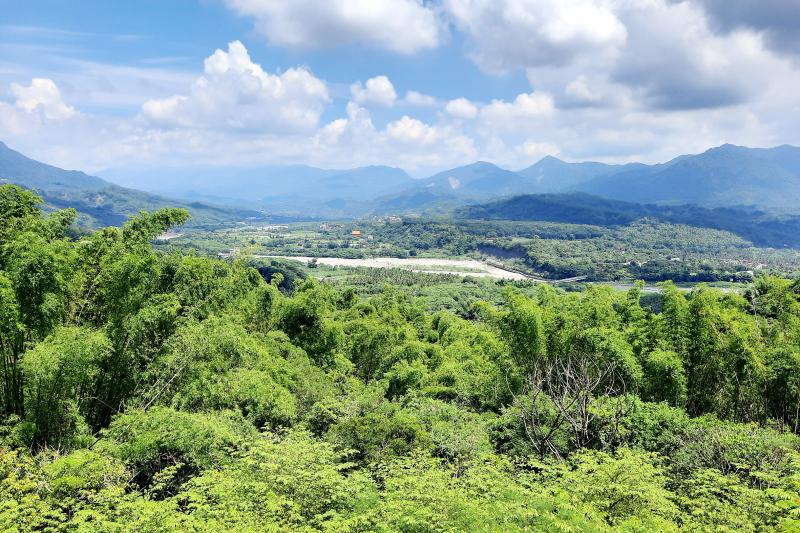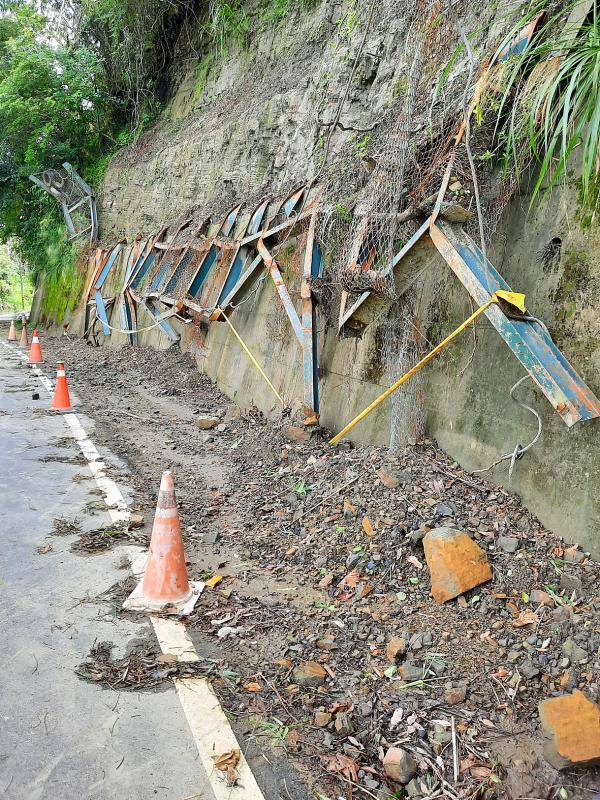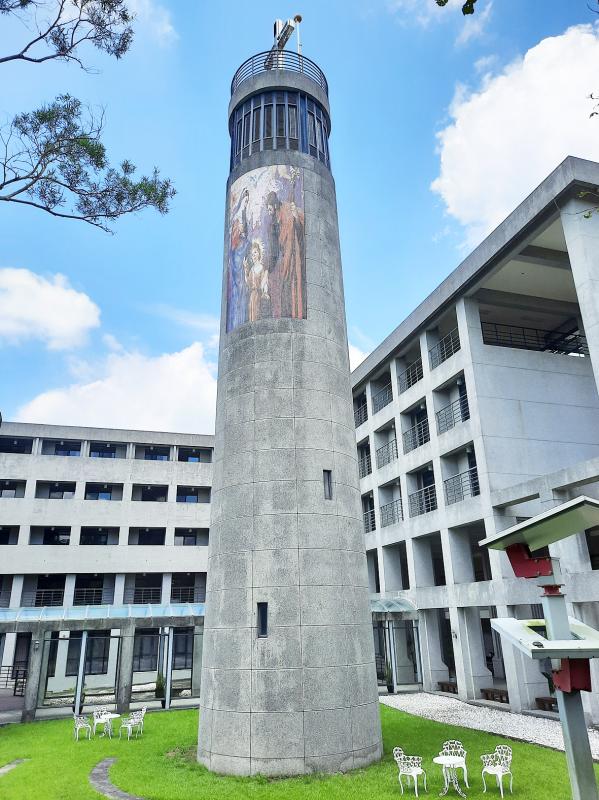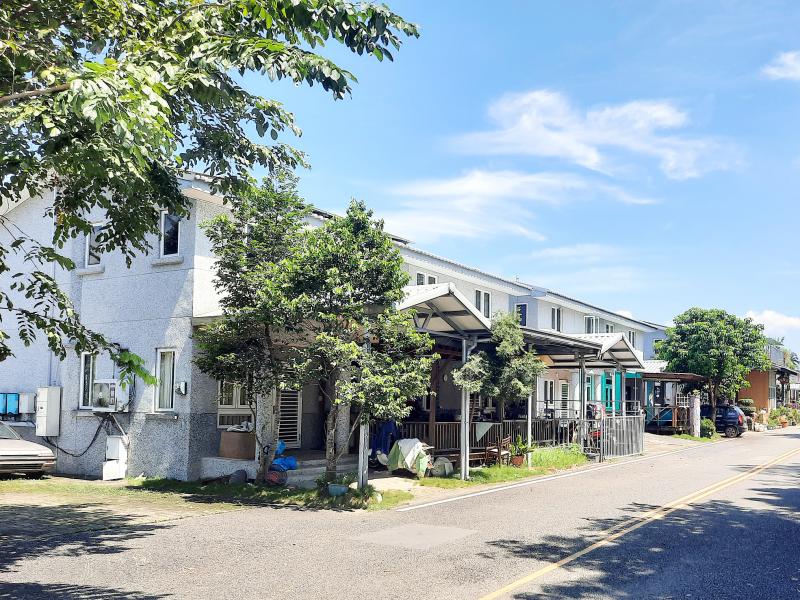Whether you like this type of landscape or not, you’ll probably agree that it’s a good thing Goushihkeng (狗屎坑) doesn’t live up to its name.
This toponym, which translates as “Dog Feces Pit,” is attached to a remote corner of Kaohsiung’s Neimen District (內門). No one lives there, although there’s a cluster of households about 1.5km away. Between Goushihkeng’s hillocks and creeks, farmers grow bananas and bamboo.
I’d set out to explore Shanlin District (杉林) in the northern interior of Kaohsiung. Because I wasn’t sure if I’d find much of interest there, I decided to take my 125cc scooter on a backcountry route, and make the day as much about the journey as the destination.

Photo: Steven Crook
Veering off Provincial Highway 3 a few kilometers north of Neimen’s famed Purple Bamboo Temple (紫竹寺), I took Kaohsiung Local Road 121 as it climbed to around 240m above sea level.
I soon found myself in a green basin dotted with pineapple plantations. Near the convergence of local roads 121 and 117, I stopped briefly in Gouping (溝坪), a small settlement and location of the area’s only elementary school.
The turnoff to Goushihkeng is 100m north of the non-descript Jinlong Temple (金龍寺) on Local Road 117, and the side road isn’t suitable for ordinary cars. Patches of slime and piles of damp leaves persuaded me to leave my scooter in the shade of a camphor tree and continue on foot.

Photo: Steven Crook
I saw not a soul, nor a dog, but the cellphone signal was strong enough to confirm I’d arrived at Goushihkeng. I was surrounded by an appealing and soothing lushness. Every sound that reached my ears was generated by nature: The trill of an insect, leaves rustling in the breeze, softly babbling water.
Inching down a muddy slope to a stream, I noticed that it looked clean but unpopulated. No fish, no tadpoles.
The morning was beginning to heat up, and I hadn’t yet crossed into Shanlin District. Riding northward, the road lacked white lines, kilometer markers, or other signs. But I wouldn’t hesitate to drive my car on it.

Photo: Steven Crook
Just before the intersection with Kaohsiung Local Road 129 — which connects Jiasian District (甲仙) with Shanlin — a pair of macaques bolted into the trees.
Turning southeast, I followed Local Road 129 past large plots managed by Taiwan Sugar Corporation (台糖, TSC). No cane has been grown hereabouts for years. Like a lot of TSC land, these former plantations are being afforested.
Crossing the Cishan River (旗山溪), I noticed that the waterway’s west bank is a good bit higher than its east bank, and visibly different in terms of geological makeup.

Photo: Steven Crook
Shanlin gained an entirely new neighborhood in the wake of 2009’s Typhoon Morakot.
To accommodate some of the thousands of people left homeless by that disaster, the authorities and NGOs moved with impressive speed. The government released TSC-owned land east of Provincial Highway 29, near Shanlin Junior High School (杉林國中), and the Buddhist Compassion Relief Tzu Chi Foundation began constructing permanent housing there before the year had ended.
Around 1,000 one and two-story houses have been built and handed over to typhoon survivors. Many residents are members of recognized Aboriginal communities. Others are of Han descent. Scores are from Siaolin (小林), a village near Jiasian that — prior to its obliteration by Morakot — fascinated researchers because it had preserved some of the traditions of the Taivoan (大滿族) a lowland Aboriginal ethnic group.

Photo: Steven Crook
A lot has been said and written about what’s known as Yuemei Da-Ai Community (月眉大愛社區), not all of it complimentary. Residents have complained that the location is so far from their original homes that they struggle to maintain the fields and orchards they still own there. At the same time, it’s inconvenient if they want to find a job in an urban area. The Buddhist emphasis on sobriety doesn’t sit well with those who chew betel nut or enjoy a drink.
Those complaints may be well founded. However, the people I saw coming and going seemed no less happy than other Taiwanese. What’s more, almost all of the houses look to still be in excellent condition. That can’t be said of quite a few decade-old structures in Taiwan.
Residents are free to personalize their properties. Unfortunately, in many cases this has meant replacing foliage with concrete, or adding an unattractive carport.

Photo: Steven Crook
On Sieli Street (協力街), four church buildings representing three different denominations stand side by side. Recognizing that Taiwan’s Aboriginal population is overwhelmingly Christian, from the outset Tzu Chi — their own Buddhist affiliation notwithstanding — intended that the community would have its own Protestant and Catholic places of worship.
Recrossing the Cishan River to begin the ride home, I saw further evidence of Taiwan’s religious diversity.
A short detour brought me to one of Taiwan’s few Muslim graveyards. It was established in 2018, to replace a cemetery at Fudingjin (覆鼎金) in central Kaohsiung.
Just a few hundred meters away as the crow flies, Mount Beatitude (真福山社福文教中心) is a Roman Catholic center for retreats, conferences and training priests.
Founded at the behest of Cardinal Paul Shan Kuo-hsi (單國璽, 1924-2012) — the only Taiwan-based cardinal in the history of the church — and inaugurated in 2011, this 27-hectare site includes a modern accommodation block, an outdoor altar made of white marble and a stand-alone steeple.
The well-kept grounds, which seem to be open to outsiders during daylight hours, are a perfect place to stretch your legs.
If you follow a religion, you’re likely to find it represented somewhere in Shanlin. But as I looked down from Mount Beatitude over the valley, all I could think about was the area’s alluring topography. For me, that’s meaning enough.
Steven Crook has been writing about travel, culture and business in Taiwan since 1996. He is the author of Taiwan: The Bradt Travel Guide and co-author of A Culinary History of Taipei: Beyond Pork and Ponlai.

Exceptions to the rule are sometimes revealing. For a brief few years, there was an emerging ideological split between the Democratic Progressive Party (DPP) and Chinese Nationalist Party (KMT) that appeared to be pushing the DPP in a direction that would be considered more liberal, and the KMT more conservative. In the previous column, “The KMT-DPP’s bureaucrat-led developmental state” (Dec. 11, page 12), we examined how Taiwan’s democratic system developed, and how both the two main parties largely accepted a similar consensus on how Taiwan should be run domestically and did not split along the left-right lines more familiar in

As I finally slid into the warm embrace of the hot, clifftop pool, it was a serene moment of reflection. The sound of the river reflected off the cave walls, the white of our camping lights reflected off the dark, shimmering surface of the water, and I reflected on how fortunate I was to be here. After all, the beautiful walk through narrow canyons that had brought us here had been inaccessible for five years — and will be again soon. The day had started at the Huisun Forest Area (惠蓀林場), at the end of Nantou County Route 80, north and east

This month the government ordered a one-year block of Xiaohongshu (小紅書) or Rednote, a Chinese social media platform with more than 3 million users in Taiwan. The government pointed to widespread fraud activity on the platform, along with cybersecurity failures. Officials said that they had reached out to the company and asked it to change. However, they received no response. The pro-China parties, the Chinese Nationalist Party (KMT) and Taiwan People’s Party (TPP), immediately swung into action, denouncing the ban as an attack on free speech. This “free speech” claim was then echoed by the People’s Republic of China (PRC),

Specialty sandwiches loaded with the contents of an entire charcuterie board, overflowing with sauces, creams and all manner of creative add-ons, is perhaps one of the biggest global food trends of this year. From London to New York, lines form down the block for mortadella, burrata, pistachio and more stuffed between slices of fresh sourdough, rye or focaccia. To try the trend in Taipei, Munchies Mafia is for sure the spot — could this be the best sandwich in town? Carlos from Spain and Sergio from Mexico opened this spot just seven months ago. The two met working in the